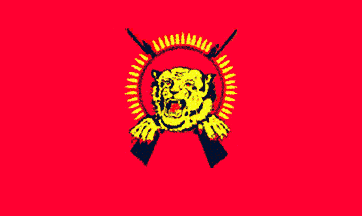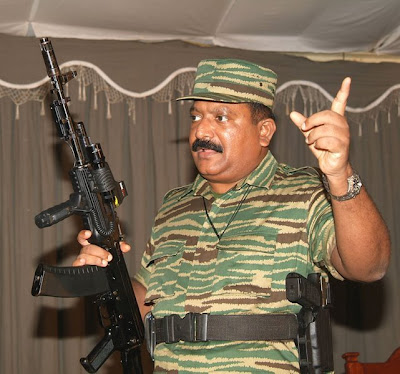The root of modern conflict goes back to British colonial rule when the country was known as Ceylon. A nationalist political movement from Sinhalese communities arose in the country in the early 20th century with the aim of obtaining political independence, which was eventually granted by the British after peaceful negotiations in 1948. Disagreements between the Sinhalese and Tamil ethnic communities flared up when drawing up the country's first post-independence constitution.
After their election to the State Council in 1936, the Lanka Sama Samaja Party (LSSP) members N.M. Perera and Philip Gunawardena demanded the replacement of English as the official language by Sinhala and Tamil. However, in 1944, J.R. Jayawardene moved in the State Council that Sinhala should replace English as the official language.
In 1956 Prime Minister S. W. R. D. Bandaranaike's passage of the "Sinhala Only Act" led to ethnic riots. The civil war is a direct result of the escalation of the confrontational politics that followed.
The formation of the Tamil United Liberation Front (TULF) with its Vaddukkodei (Vattukottai)) resolution of 1976 led to a hardening of attitudes.
In 1963, documents relating to a separate Tamil state of 'Tamil Eelam' began to circulate. At this time, Anton Balasingham, an employee of the British High Commission in Colombo, began to participate in separatist activities. He later migrated to Britain, where he became the chief theoretician of the Liberation Tigers of Tamil Eelam. In the late 1960s, several Tamil youth, among them Velupillai Prabhakaran also became involved in these activities. These forces together formed the Tamil New Tigers in 1972. This was formed around a racist ideology which looked back to the 1st Millennium Chola Empire (the Tiger was the emblem of that empire) and an action program based on the film persona of Clint Eastwood, who was Prabhakaran's hero.
A further movement, the Eelam Revolutionary Organisation of Students, and formed in ManchesterLondon; it became the backbone of the Eelamist movement in the diaspora, arranging passports and employment for immigrants and levying a heavy tax on them. It became the basis of the eelamist logistical organisation, later taken over entirely by the Liberation Tigers of Tamil Eelam.
 Supported by the on-going politics of conflict in Sri Lanka, politicized Tamil youth in the North and the East started to form militant groups. These groups developed independently of the Colombo Tamil leadership, and in the end rejected and annihilated them. The most prominent of these groups was the TNT, which changed its name to the Liberation Tigers of Tamil Eelam or the LTTE in 1976. The LTTE initially carried out a campaign of violence against the state, particularly targeting policemen and also moderate Tamil politicians who attempted a dialogue with the government. Their first major operation was the assassination of the mayor of Jaffna, Alfred Duraiappah in 1975 by Prabhakaran.
Supported by the on-going politics of conflict in Sri Lanka, politicized Tamil youth in the North and the East started to form militant groups. These groups developed independently of the Colombo Tamil leadership, and in the end rejected and annihilated them. The most prominent of these groups was the TNT, which changed its name to the Liberation Tigers of Tamil Eelam or the LTTE in 1976. The LTTE initially carried out a campaign of violence against the state, particularly targeting policemen and also moderate Tamil politicians who attempted a dialogue with the government. Their first major operation was the assassination of the mayor of Jaffna, Alfred Duraiappah in 1975 by Prabhakaran.
In July 1983, the LTTE launched a deadly attack on the military in the North of the country, killing 13 soldiers. Using the nationalistic sentiments to their advantage, the Jayawardena now organized massacres and pogroms in Colombo, the capital, and elsewhere (see Black July) - although several pogroms had been reported in rural areas prior to the LTTE attack. Between 400 and 3,000 Tamils were estimated to have been killed, and many more fled Sinhalese-majority areas. This is usually considered the beginning of the civil war.
Apart from the LTTE, there initially was a plethora of militant groups. The LTTE's position, adopted from that of the PLO, was that there should be only one. Initially the LTTE gained prominence due to devastating attacks such as the massacre of civilians at the Kent and Dollar Farms in 1984 and the Anuradhapura massacre of 146 civilians in 1985. The Anuradhapura massacre was apparently retaliated for by government forces with the Kumudini boat massacre in which over 23 Tamil civilians died. Over time the LTTE merged with or largely exterminated almost all the other militant Tamil groups. As a result, many Tamil splinter groups ended up working with the Sri Lankan government as paramilitaries or denounced violence and joined mainstream politics, and some legitimate Tamil-oriented political parties remain, all opposed to LTTE's vision of an independent state.
 Peace talks between the LTTE and the government began in Thimphu in 1985, but they soon failed, and the war continued. In 1986 many civilians were massacred as part of this conflict. In 1987, government troops pushed the LTTE fighters to the northern city of Jaffna. In April 1987, the conflict exploded with ferocity, as both the government forces and the LTTE fighters engaged each other in a series of bloody operations.
Peace talks between the LTTE and the government began in Thimphu in 1985, but they soon failed, and the war continued. In 1986 many civilians were massacred as part of this conflict. In 1987, government troops pushed the LTTE fighters to the northern city of Jaffna. In April 1987, the conflict exploded with ferocity, as both the government forces and the LTTE fighters engaged each other in a series of bloody operations.
The Sri Lankan military launched an offensive, called “Operation Liberation” or “Vadamarachchi Operation”, during May–June 1987, to regain the territory in Jaffna peninsula from the LTTE's control. This offensive marked the Sri Lankan military's first ever conventional warfare in Sri Lankan soil since independence. The military offensive was successful and the LTTE leader Prabhakaran and the Sea Tiger leader Soosai narrowly escaped from advancing troops at Valvettithurai. The key military personnel who involved in the operation were Lt Col. Vipul Boteju, Lt Col. Sarath Jayawardane, Col. Vijaya Wimalaratne, Brig. Denzil Kobbekaduwa and Maj Gotabaya Rajapaksa.
In July 1987, the LTTE carried out their first suicide attack: "Captain Miller" of the Black Tigers drove a small truck with explosives through the wall of a fortified Sri Lankan army camp, reportedly killing forty soldiers. Since then they have carried out over 170 suicide attacks, more than any other organization in the world, and the suicide attack has become a trademark of the LTTE, and a characteristic of the civil war.

 Bus bombing by LTTE in Moratuwa, Sri Lanka: Read source
Bus bombing by LTTE in Moratuwa, Sri Lanka: Read source



